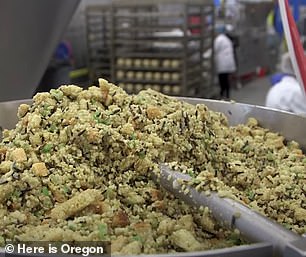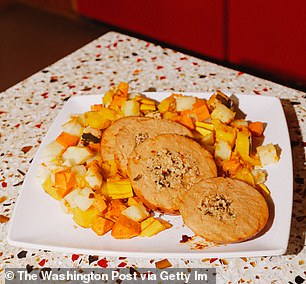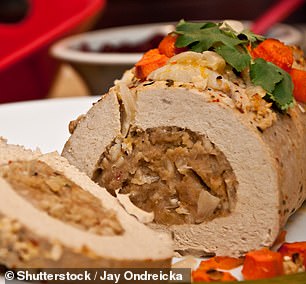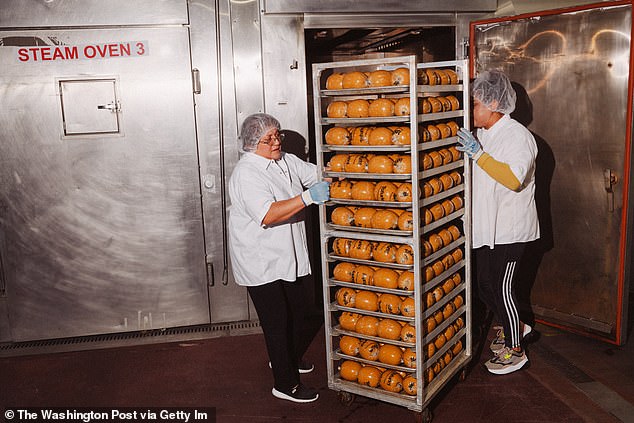Fascinating video inside a plant-based turkey factory that’ll feed millions of veggie Americans this year is guaranteed to put you off your Thanksgiving meal
It’s a Thanksgiving tradition as cherished as the corny “dad jokes” and cranky debates it generates around the dinner table: the vegetarian and vegan “Tofurky” roast.
Every year, the company that makes the tofu- and wheat-based turkey substitute is in a mad rush to shift production of its line of everyday plant-based meats and deli meats to deliver enough of its signature roasts in time for the holidays.
Employees create, bake and package 6,000 holiday roasts in each 10-hour shift leading up to the holidays at the company’s Hood River plant in Oregon.
About 7.5 million Tofurky roasts have been sold since the savory appetizer was first invented in 1980.
But the process of mixing industrial quantities of tofu and wheat ‘masa’ to wrap the interior of each Tofurky with wild rice filling isn’t always pretty. Here’s a look inside a factory where the vegan sausage is made.
Every year, the company that makes the tofu- and wheat-based turkey substitute, Tofurky, shifts production of its line of everyday plant-based cold cults and meat substitutes in a mad rush to supply enough of its signature roasts for the holidays.


Employees create, bake and package 6,000 holiday roasts in each 10-hour shift leading up to the holidays at the company’s Hood River plant in Oregon. About 7.5 million Tofurky roasts have been sold since the savory appetizer was first invented in 1980
In total, about 175 employees, including 50 at parent company Turtle Island Foods’ Hood River plant alone, jump into production each year to bring the Tofurky to market.
Each shift, four people are responsible for making the “masa,” the tofu and wheat dough, which is mixed with canola oil, water and savory spices for the appropriate fall texture and flavor.
Another employee takes on the lonely task of making all the wild rice filling in the center of each holiday roast, mixing in bread crumbs, celery, onion, carrot, leek and other seasonings.
Each shift, a different employee has the task of putting together the ingredients for Tofurky’s dry herb mix.
The two mixtures are then combined in an industrial procedure inspired by the factory production of Nabisco’s Fig Newton bars: a nested funnel within a funnel that directs the two savory goops into a tube within a tube.
Once cooked and cooled, the packages are then quickly packed into their final consumer packaging for shipping by anyone available.
A single Tofurky roast with gravy, which will feed about five people, costs $13.50.
“97 percent of our production takes place at our own facility in Hood River,” he said Jaime Athos, CEO of Turtle Island Foods, who took on the role of his stepfather Seth.
‘We had challenges around the packaging. We were also blindsided by the huge increases in gluten prices, caused first by Covid and then by the war in Ukraine (a major exporter of wheat worldwide),” as Athos related. AgFunderNews this March.


A single Tofurky roast with gravy feeds about five. The two mixtures, the Tofurky and the filling, are combined in an industrial procedure inspired by the production of Nabisco’s Fig Newtons: a nested funnel within a funnel that directs the two savory goops into a tube within a tube.

In perhaps the most surprising phase of Tofurky’s production, each holiday roast is scanned via X-ray to ensure nothing unwanted or suspicious has been accidentally baked into it.

While no law mandates the X-ray step, it’s this extra step that has made the kneaded doughy ball of tofu and wheat gluten such an enduring, if quirky, holiday specialty.
In perhaps the most surprising stage of each Tofurky’s production, the holiday roast is scanned via X-ray to ensure nothing unwanted or suspicious has been accidentally baked into the mixture.
While no law officially mandates the X-ray step, it’s this extra step that has made the kneaded doughy ball of tofu and wheat gluten such an enduring, if quirky, holiday specialty.
Athos has said some have called for the company to produce a gluten-free Tofurky, but dedicated customers are attached to the current formula, even though it doesn’t taste much like turkey.
“I think there is a little bit of a risk if you get too close to the exact eating experience of meat,” Athos told the newspaper Washingtonpost as part of a recent visit to the Tofurky factory.
“There’s this idea of the uncanny valley: if something is close, but not quite, that’s worse than being noticeably away from the target,” he added. ‘For us it’s more about: ‘Is it good to eat? Is it a satisfying and flavorful eating experience?’ That’s so much more on our minds than, “Is it exactly the same as meat?”
